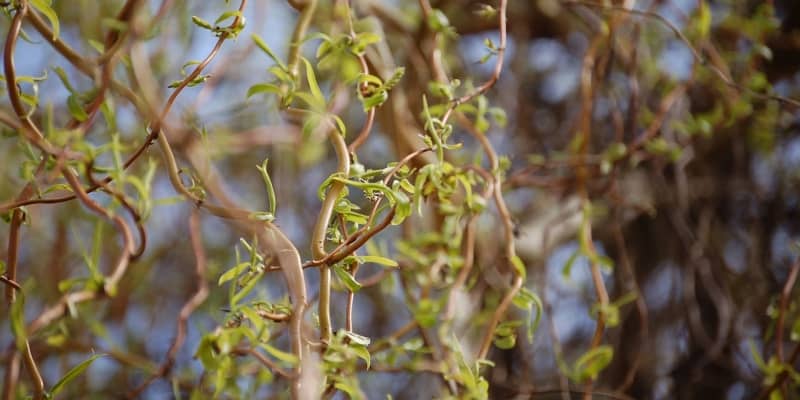Flower Glossary is reader-supported. When you buy through links on our site, we may earn an affiliate commission.
Salix babylonica Tortuosa is a member of the willow family and is also known as the Dragon’s Claw Willow, curly willow tree, or corkscrew willow. All these names refer to the tree’s most striking feature – its uniquely twisted branches that corkscrew upward in an unruly mass of green foliage.
Both homeowners and landscapers alike favor these beautiful trees and choose them to add texture and shade to gardens and backyards. Dragon’s Claw Willow also grows fairly quickly. So, you won’t have to wait decades to enjoy the benefits of a medium height tree if you plant it as a sapling.

Table of Contents
A Concise Guide to Salix babylonica Tortuosa
The Dragon’s Claw Willow has its origins in North Asia, where it’s also often used in bonsai or cultivated as shrubs. The unique shape of this twirled willow means that it looks very striking in snowy conditions, and its twisted branches also offer a wonderful decorative touch to flower arrangements or dried home decor.
It is a very good tree option for gardens with damp soil that need some visual interest in the colder months. However, the Salix babylonica Tortuosa is just as lovely in spring, when its catkins flutter on the breeze in beautiful yellow clumps, before giving way to the lush, green foliage of summer. In short, Salix babylonica Tortuosa is a visual treat all year round!
This particular willow will grow to approximately 6 by 4 meters in two decades. Alternatively, you can train it into a screen or hedge if you grow it as a multi-stem plant from ground level up. Salix babylonica Tortuosa is suited to most soils and will thrive when given sufficient water.

How to Plant & Care for a Dragon’s Claw Willow
The great thing about the Dragon’s Claw Willow is that you can plant it at any time of year. Follow the following steps for best results:
- Measure the root mass of the tree and find a suitable space where you’ll be able to dig a hole that is as deep as the mass, and at least two times as wide.
- Remove all grass and weeds within a meter of where you intend to dig the hole.
- Dig your hole and sprinkle root growth mixture to boost growth from the outset.
- Remove your tree from its pot, loosen the roots gently and transfer it to the hole that you dug.
- Mix the soil you dug out with 50% compost, place the tree in the hole, fill it back up with this mixture, and press/stamp down firmly.
- Refrain from banking up the soil around the tree collar.
- Water regularly (ideally daily) if you plant it in spring or summer. Increase the watering if the weather is particularly dry or hot. If you plant in the fall, you may only need a little supplementary irrigation.
- Take care to keep the area around your tree free from weeds and grasses to give it a good chance to grow.
- If there are rabbits where you live, take care to put up a guard around the tree – rabbits adore Dragon’s Claw Willows.
- Do not prune the tree for the first year after planting. Allow it to establish itself and find its natural shape. In the second year, prune away any broken or diseased branches whenever you see any and clear away lower branches in winter to promote a clear, strong stem.

Pests & Diseases To Look Out For
Aside from the rabbits mentioned above, Salix babylonica Tortuosa is also susceptible to a number of other pests and diseases.
The most prevalent pests include aphids and gypsy moths that eat the tree’s leaves, and lace bugs that cause yellowing. Willow leaf beetles also feed on the leaves, while poplar and wild borer drill into the trunk. The latter is the most worrying, as they can kill a tree if left unattended.
The best course of action is to administer a pesticide immediately. Contact your local nursery to get advice on which brand and dosage is best suited in your region and the type of pest.
The diseases that you may encounter in a corkscrew willow include willow scab, which kills young leaves, and black canker, which causes lesions on the branches and stems. Crown gall and powdery mildew may also present from time to time.
Take action immediately when you notice any symptoms. If you catch these diseases early, they can be treated. Left to spread, they could kill the tree and infect others nearby.
Final Thoughts
Salix babylonica Tortuosa, or the Dragon’s Claw Willow, is known for its uniquely twisted branches that make it a favorite among landscapers, home gardeners, florists, bonsai artists, and more. It’s a great shade tree with very aesthetic branches that look wonderful throughout the year. While it requires quite a bit of water to grow well, it’s not too difficult to grow and maintain once mature.
